
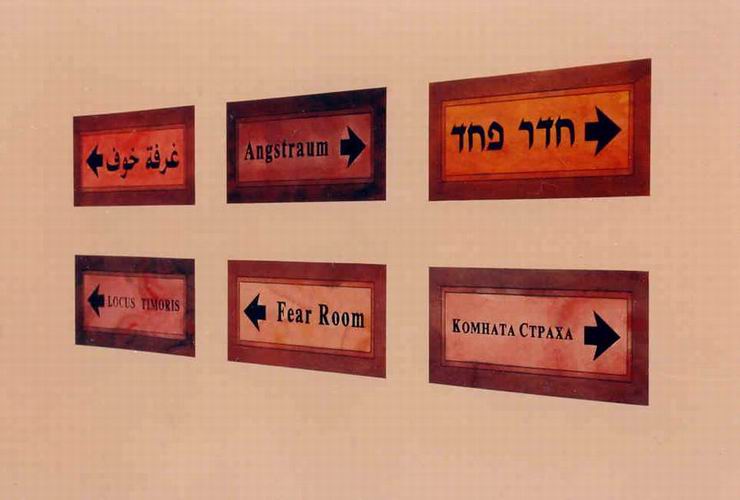
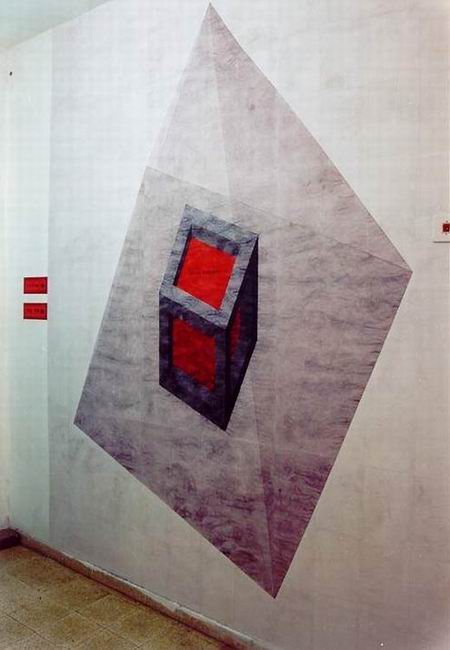
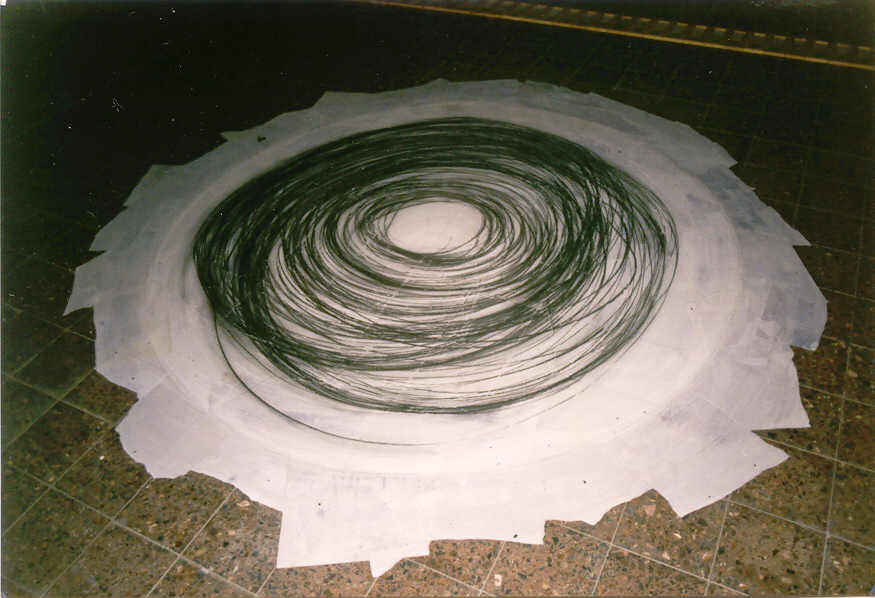
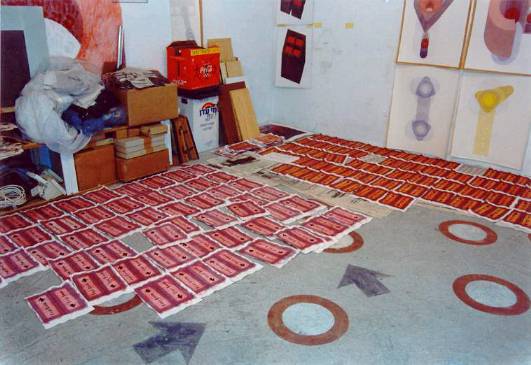
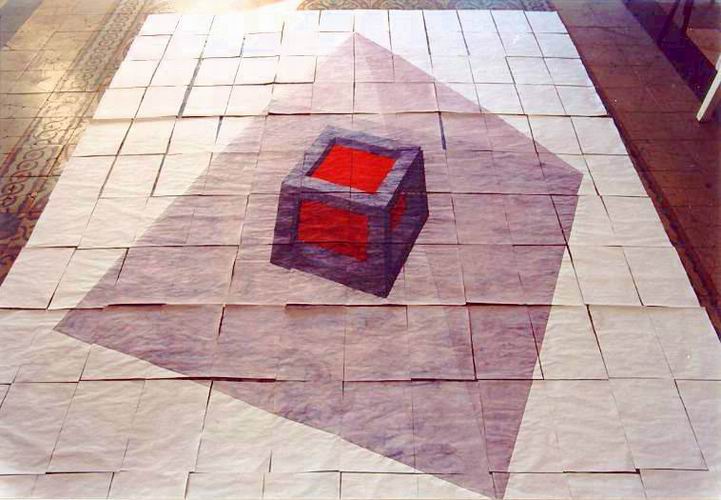
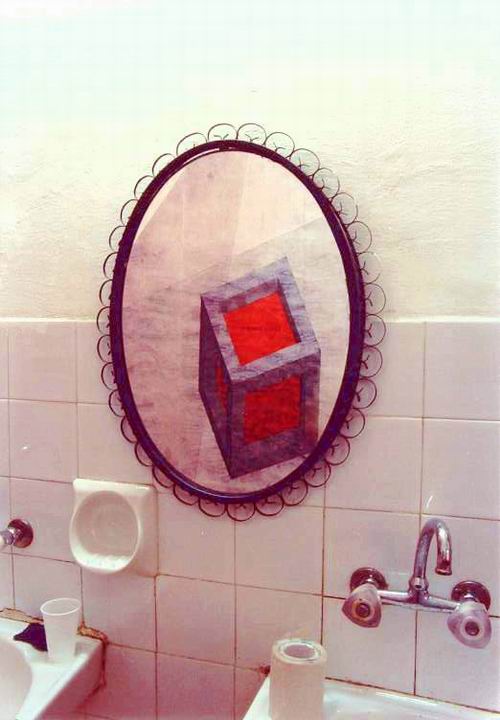
Installatie in Galerie Musrara, Jeruzalem, 1997
All over the building signs in six languages point to a "Fear Room". They lead to a remote place. There is a painting of a cube, filled with red. Its sides resemble windows.
Why do I fear painting? Why do I fear writing? Why do I fear creating?
I have a problem as an artist. I will do anything to avoid creating art, as long as there is no clear deadline. I love to paint, but without a deadline I avoid working. Instead I indulge in activities which equal masturbation, like cataloguing my own drawings or counting how many kilometers I traveled by train in 1991. To prevent myself from total ruin I deleted all the games from my computer. The same attitude of avoidance applies to writing. I put off writing this article by designing a witty computer program for “Sinterklaas”. Every year on the 5th of December people in Holland give each other presents, accompanied by poems in which they criticize each other with sarcastic humour.
To make myself start working in my studio I take a pencil and move it around and around over a sheet of paper, until it tears apart. I repeat that ritual until my fear dissolves, and gradually the thoughts and emotions, which were kept imprisoned, are set free. In 1993 in Groningen, I exhibited Transparent Fear, an installation consisting of three huge dark grey circles painted on the wall. I wrote the word “angst”, the Dutch and German equivalent for ”fear” in them many times.
My original plan for Musrara was to fill the building with signs, as many as possible. I just did not know where they should lead to. To the shelter? To the Department for the Re-division of the Re-united City? Such signs would be more suitable to the Kafkaesque Jerusalem Municipality. Any meaning I gave them became more significant than the signs themselves. Then Fear came to my mind, first hesitatingly, then very strongly. I decided that my signs should lead to a “Fear Point” or a “Fear Room”, although I had not decided yet if they would lead to an actual room. The visitor might also be misled.
Soon the floor of my studio was covered with hundreds of freshly watercoloured Fear Room signs in Hebrew, Arabic, Russian, English, German and Latin. The masses of more or less equal signs, with text in a frame, reminded me of the time I collected stamps. I especially indulged in the quantities of identical portraits of Queen Elizabeth in different colours and with different values from various countries. I never lost that love for repetition.
Working like mad, I avoided making a final decision about what the Fear Room would look like and if I would make one at all. I considered using two windows I found on the street to cover a painted Fear Room, but my sketches failed to satisfy me. Only one week before the opening, while looking almost in panic through old studies, I found a watercolour of a cube. Its sides resembled windows, framing a strong red inside the cube. The blood-like red was associated with fear.
The decision to use that design as a symbol of a fear room set free a lot of energy. After defining the form and measures of the Fear Room cube by making designs on different paper and on different scales, I made the final painting on nine sheets of thin paper. As usual, I used strongly diluted watercolous, which made mountains and valleys in the paper and formed marble patterns when the lakes dried. I painted the cube inside a transparent pyramid. In February of this year I exhibited a kind of Fear Point in Givat Haviva. I installed a large pyramid of cotton threads and put a smaller one inside it, which covered a third one made of pulp. I called it Exercise in Hiding Fear.
Three days before the opening in Musrara I had a flashback nightmare, which had haunted me repeatedly as a little child: I am walking outside. Suddenly a siren announces a monster is in the air. It will swallow anyone who does not get inside at once and close all the doors and windows. Terrified, I try to find refuge at home. At times I managed to escape by getting inside. But I remember with fear those times when the cloudy monster swallowed me up and destroyed me in a whirlpool.
Now I wonder whether this childhood dream might be a metaphor for the way I presently experience fear of exposing my artworks or writings. Is it coincidental that I arrived in a country where shelters and security rooms play such an important role in daily life? My studio is a bomb shelter. And what about those fear-hiding Israelis? Do they build shelters because of the possibility of war, or do they do their utmost to provoke a war in order to create a need for shelters? Israel is the only country I know of, where people in modern times close themselves off from the rest of the world with a particular language, written with exclusive characters that daze the eyes of newcomers and limit their ability to read or take part in the culture.
My nightmare expresses a tremendous fear, hidden within, beating uncontrolled by reason, like the heart. Even now I fear to deal with it and I delete sentences that my intellect considers too emotional or too personal. “Too much like art therapy!” it says. I hide myself. I close windows. I have to find a way to dissolve it in writing just as I make circles in art.
I cut the cube painting (25 x 210 cm.) in little pieces. Before gluing it to the wall I laid the pieces down on the floor. The deformation and disintegration of the cube seemed to add power. I attached it like planned on the toilet wall, opposite the mirror and taps, but I recorded the floor-image in my memory and on film.
With pleasure I would have covered all the walls of the building totally with Fear Room signs, but I was too self-restrained. I did not want to bother the other artists too much. That is a very Dutch attitude. However, from any spot in the building one can see at least one of them. I wonder how the same installation would look when it fills a much larger building, like the new Tel Aviv Bus Station or the Jerusalem Municipality.


